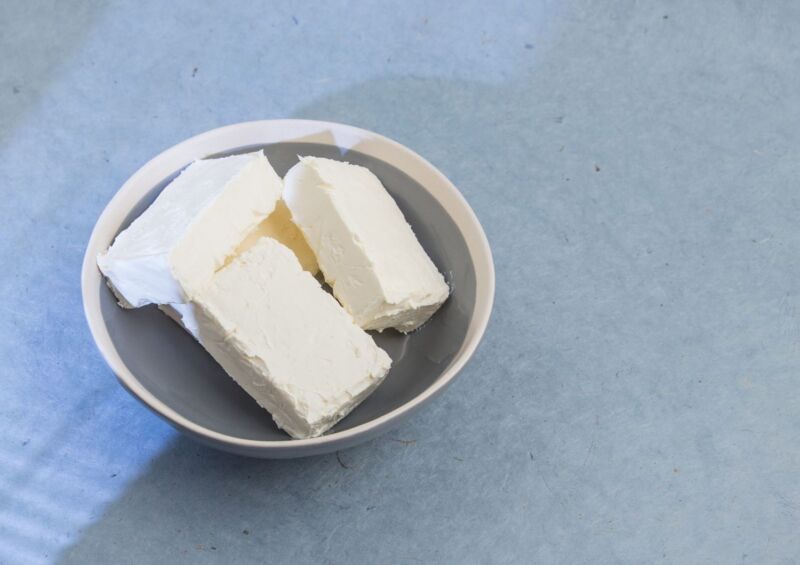How Long Can Cream Cheese Sit Out?
Cream cheese is a popular and versatile dairy product used in many sweet and savory dishes. However, like all perishable foods, it requires proper storage to prevent bacterial contamination and foodborne illness. So how long can cream cheese sit out unrefrigerated before it goes bad?
Storing Cream Cheese in the Fridge
The US Department of Agriculture (USDA) recommends storing cream cheese in the refrigerator at 40°F or below to inhibit bacteria growth. I make sure to follow this guidance to prevent my cream cheese from spoiling.
The USDA’s Food Safety and Inspection Service advises refrigerating cream cheese opened or unopened in its original wrapper for optimal freshness and food safety. This helps prevent pathogenic bacteria like Listeria, Salmonella, and E. coli from multiplying to dangerous levels at room temperature.
According to the USDA, cream cheese should not sit out at room temperature for more than two hours. If I’m running errands, I try to go grocery shopping last to limit the time cold items like cream cheese will be outside the fridge.
If store-bought pre-packaged sandwiches containing cream cheese have been left out for longer than two hours, it’s best to throw them out. Bacteria can grow even if the cream cheese itself is still cold.
Leaving Cream Cheese Out Overnight

While it may be tempting to leave cream cheese out overnight to soften, this presents a major food safety risk. Pathogenic bacteria can multiply rapidly at room temperature, even if the cream cheese still feels cold.
For food safety, cream cheese should not be left at room temperature for more than three to four hours maximum. A safer method is to take cream cheese out of the fridge about 20-25 minutes before use. This will sufficiently soften it for spreading.
Cream Cheese Expiry
An unopened package of cream cheese has a relatively long shelf life, staying fresh for up to three weeks past the “best by” date when stored in the refrigerator.
However, an opened package has a shorter shelf life of just a few days. For optimal freshness and flavor, I use up cream cheese within one week of opening.
One exception is brick cream cheese wrapped in foil. This type can last two months past its expiry date if the foil is intact, thanks to the airtight seal.
Cream Cheese in Baking
When baking with cream cheese, I soften it by microwaving on half power for 10-15 seconds. This prevents the need to leave it out and risk spoilage.
Cream cheese adds rich flavor and texture to frostings, dips, cheesecake fillings, and more. It’s one of my go-to ingredients for making desserts extra decadent.
Signs Your Cream Cheese Has Spoiled
Cream cheese is perishable and can spoil if not stored properly. Watch for these key signs of spoiled cream cheese before eating it:
Appearance
- Mold spots – any fuzzy or slimy growth indicates spoilage.
- Unnatural colors like yellow, green, blue, or pink tinges. Good cream cheese should be white.
- Watery consistency instead of being thick and creamy.
- Dry, cracked texture rather than being smooth.
Smell
- Strong, unpleasant odors like sourness or ammonia-like scents.
- If it smells off, it likely has bacteria growth.
Texture
- Soft or runny texture when cream cheese should be firm and spreadable.
- Slime formation due to bacterial overgrowth.
Taste
- Strong bitter, sour, or unpleasant flavors.
- Tangy or acidic taste from lactic acid development.
When in Doubt, Throw it Out!
Don’t taste cream cheese that looks or smells questionable – err on the side of caution. Cream cheese with any signs of spoilage should be discarded. Consuming spoiled cream cheese can cause food poisoning.
Always inspect cream cheese for freshness before use. And remember to store it sealed in the fridge at 40°F or below to extend its shelf life. Proper refrigeration prevents spoilage and keeps cream cheese safe to enjoy.
Tips for Extending Cream Cheese’s Shelf Life
Here are my top tips for keeping cream cheese fresh longer:
- Refrigerate unopened cream cheese in original packaging.
- Transfer opened cream cheese to an airtight container. Foil wrappings work great.
- Use clean utensils when scooping out cream cheese to prevent cross-contamination.
- Check expiry dates and use oldest packages first.
Proper storage is key for enjoying cream cheese before it expires and avoiding foodborne illness. A bit of planning goes a long way.
The Takeaway on Leaving Cream Cheese Out
Cream cheese is best stored sealed in the refrigerator at 40°F or below. Leaving cream cheese out for more than two hours poses a health risk as bacteria can multiply quickly at room temperature. For food safety, discard cream cheese if it has been unrefrigerated for longer than this timeframe.
With its stellar flavor and creamy texture, cream cheese is a fridge staple I can’t live without. However, improper storage can make cream cheese dangerous to eat. Following safe handling guidelines helps prevent foodborne illness from spoiled dairy products.
I hope these tips help you keep your cream cheese fresh and safe for longer. Please share with family and friends – we can all benefit from practicing smart cream cheese storage. Enjoy all the delicious possibilities cream cheese makes possible, without worry.






